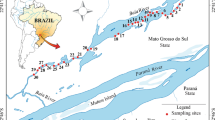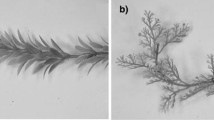Abstract
A considerable amount of research has investigated the influence of habitat structure on predator success, yet few studies have explored the implications for community structure and food-web dynamics. The relative importance of macrophyte structure and fish predation on the composition of the macroinvertebrate and periphyton communities in a lowland river was investigated using a multifactorial caging experiment. We hypothesised that: (1) fish predators are less effective in a more structurally complex macrophyte analogue; (2) strong direct and indirect effects of fish predators (e.g. trophic cascades) are less likely to occur in a structurally complex habitat; and (3) the strength of these patterns is influenced by the composition of the prevailing community assemblage. We measured the abundance and composition of the macroinvertebrate and periphyton communities associated with three different-shaped macrophyte analogues, under different fish predator treatments and at different times. Macrophyte analogue architecture had strong, consistent effects on both the macroinvertebrate and periphyton communities; both were most abundant and diverse on the most structurally complex plant analogue. In contrast, the fish predators affected only a subset of the macroinvertebrate community and there was a suggestion of minor indirect effects on periphyton community composition. Contrary to expectations, the fish predators had their strongest effects in the most structurally complex macrophyte analogue. We conclude that in this system, macrophyte shape strongly regulates the associated freshwater assemblage, resulting in a diverse community structure less likely to exhibit strong effects of fish predation.




Similar content being viewed by others
References
Anderson MJ (2001) A new method for non-parametric multivariate analysis of variance. Austral Ecol 26:32–46
Anderson MJ (2003) XMATRIX: a FORTRAN computer program for calculating design matrices for terms in ANOVA designs in a linear model. University of Auckland, Auckland
Anderson MJ (2004) DISTLMv. 5: a FORTRAN computer program to calculate a distance-based multivariate analysis for a linear model. University of Auckland, Auckland
Carpenter SR, Kitchell JF, Hodgson JR, Cochran PA, Elser JJ, Elser MM, Lodge DM, Kretchmer D, He X, von Ende CN (1987) Regulation of lake primary productivity by food web structure. Ecology 68:1863–1876
Chilton EWII (1990) Macroinvertebrate communities associated with three aquatic macrophytes (Ceratophyllum demersum, Myriophyllum spicatum, and Vallisneria americana) in Lake Onalaska, Wisconsin. J Freshw Ecol 5:455–466
Coen LD, Heck KLJ, Abele LG (1981) Experiments on competition and predation among shrimps of seagrass meadows. Ecology 62:1484–1893
Crowder LB, Cooper WE (1982) Habitat structural complexity and the interaction between bluegills and their prey. Ecology 63:1802–1813
Crowder LB, McCollum EW, Martin TH (1998) Changing perspectives on food web interactions in lake littoral zones. In: Jeppesen E, Sondergaard M, Sondergaard M, Christoffersen K (eds) The structuring roles of submerged macrophytes in lakes. Springer, Berlin Heidelberg New York, pp 240–249
de Szalay FA, Resh VH (1996) Spatial and temporal variability of trophic relationships among aquatic macroinvertebrates in a seasonal marsh. Wetlands 16:458–466
Diehl S (1992) Fish predation and benthic community structure: the role of omnivory and habitat complexity. Ecology 73:1646–1661
Diehl S, Kornijów R (1998) Influence of submerged macrophytes on trophic interactions among fish and macroinvertebrates. In: Jeppesen E, Sondergaard M, Sondergaard M, Christoffersen K (eds) The structuring role of submerged macrophytes in lakes. Springer, Berlin Heidelberg New York, pp 24–46
Dodson SI, Crowl TA, Peckarsky BL, Kats LB, Covich AP, Culp JM (1994) Nonvisual communication in freshwater benthos—an overview. J N Am Benthol Soc 13:268–282
Dufrêne M, Legendre P (1997) Species assemblages and indicator species: the need for a flexible asymmetrical approach. Ecol Monogr 67:345–366
Dvořak J, Best EPH (1982) Macroinvertebrate communities associated with the macrophytes of Lake Vechten: structural and functional relationships. Hydrobiologia 95:115–126
Gooderham J, Tsyrlin E (2002) The waterbug book. CSIRO, Melbourne
Gotceitas V, Colgan P (1989) Predator foraging success and habitat complexity: quantitative test of the threshold hypothesis. Oecologia 80:158–166
Gregg WW, Rose FL (1982) The effects of aquatic macrophytes on the stream microenvironment. Aquat Bot 14:309–324
Harris RJ (1975) A primer of multivariate statistics. Academic Press, New York
Heck KLJ, Crowder LB (1991) Habitat structure and predator-prey interactions in vegetated aquatic systems. In: Bell SS, McCoy ED, Mushinsky HR (eds) Habitat structure: the physical arrangement of objects in space. Chapman and Hall, London, pp 281–299
Humphries P (1995) Life history, food and habitat of southern pygmy perch, Nannoperca australis, in the Macquarie River, Tasmania. Mar Freshw Res 46:1159–1169
Humphries P (1996) Aquatic macrophytes, macroinvertebrate associations and water levels in a lowland Tasmanian river. Hydrobiologia 321:219–233
Hurlbert SH (1984) Pseudoreplication and the design of ecological field experiments. Ecol Monogr 54:187–211
James PL, Heck KLJ (1994) The effects of habitat complexity and light intensity on ambush predation within a simulated seagrass habitat. J Exp Mar Biol Ecol 176:187–200
Jeffries M (1993) Invertebrate colonization of artificial pondweeds of differing fractal dimension. Oikos 67:142–148
Leber KM (1985) The influence of predatory decapods, refuge, and microhabitat selection on seagrass communities. Ecology 66:1951–1964
Martin TH, Crowder LB, Dumas CF, Burkholder JM (1992) Indirect effects of fish on macrophytes in Bays Mountain Lake: evidence for a littoral trophic cascade. Oecologia 89:476–481
McArdle BH, Anderson MJ (2001) Fitting multivariate models to community data: a comment on distance-based redundancy analysis. Ecology 82:290–297
McCann KA, Hastings A, Huxel GR (1998) Weak trophic interactions and the balance of nature. Nature 395:794–798
McCoy ED, Bell SS (1991) Habitat structure: the evolution and diversification of a complex topic. In: Bell SS, McCoy ED, Mushinsky HR (eds) Habitat structure: the physical arrangement of objects in space. Chapman and Hall, London, pp 3–27
McIntosh AR, Townsend CR (1996) Interactions between fish, grazing invertebrates and algae in a New Zealand stream: a trophic cascade mediated by fish-induced changes to grazer behaviour? Oecologia 108:174–181
Nandakumar K (1996) Importance of timing of panel exposure on the competitive outcome and succession of sessile organisms. Mar Ecol Prog Ser 131:191–203
Nelson WG, Bonsdorff E (1990) Fish predation and habitat complexity: are complexity thresholds real? J Exp Mar Biol Ecol 141:183–194
O’Connor NA (1993) Resource enhancement of grazing mayfly nymphs by retreat-building caddisfly larvae in a sandbed stream. Aust J Mar Freshw Res 44:353–362
Pace ML, Cole JJ, Carpenter SR, Kitchell JF (1999) Trophic cascades revealed in diverse ecosystems. Trends Ecol Evol 14:483–488
Parker JD, Duffy JE, Orth RJ (2001) Plant species diversity and composition: experimental effects on marine epifaunal assemblages. Mar Ecol Prog Ser 224:55–67
Persson L, Eklöv P (1995) Prey refuges affecting interactions between piscivorous perch and juvenile perch and roach. Ecology 76:70–81
Polis GA (1999) Why are parts of the world green? Multiple factors control productivity and the distribution of biomass. Oikos 86:3–15
Polis GA, Sears ALW, Huxel GR, Strong DR, Maron J (2000) When is a trophic cascade a trophic cascade? Trends Ecol Evol 15:473–475
Power ME (1990) Effects of fish in river food webs. Science 250:811–814
Power ME (1992) Habitat heterogeneity and the functional significance of fish in river food webs. Ecology 73:1675–1688
Price JE, Morin PJ (2004) Colonization history determines alternative community states in a food web of intraguild predators. Ecology 85:1017–1028
Quinn GP, Keough MJ (2002) Experimental design and data analysis for biologists. Cambridge University Press, Cambridge
R Development Core Team (2005) R: a language and environment for statistical computing. R Foundation for Statistical Computing
Rader RB (1997) A functional classification of the drift: traits that influence invertebrate availability to salmonids. Can J Fish Aquat Sci 54:1211–1234
Rooke B (1986) Macroinvertebrates associated with macrophytes and plastic imitations in the Eramosa River, Ontario, Canada. Arch Hydrobiol 106:307–325
Rosemond AD (1996) Indirect effects of herbivores modify predicted effects of resources and consumption on plant biomass. In: Polis GA, Winemiller KO (eds) Food webs: integration of patterns and dynamics. Chapman and Hall, New York, pp149–159
Savino JF, Stein RA (1982) Predator-prey interaction between largemouth bass and bluegills as influenced by simulated, submersed vegetation. Trans Am Fish Soc 111:255–266
Stoner AW, Lewis FGI (1985) The influence of quantitative and qualitative aspects of habitat complexity in tropical seagrass meadows. J Exp Mar Biol Ecol 94:49–40
Strong DR (1992) Are trophic cascades all wet? Differentiation and donor-control in speciose ecosystems. Ecology 73:747–754
Swisher BJ, Soluk DA, Wahl DH (1998) Non-additive predation in littoral habitats: influences of habitat complexity. Oikos 81:30–37
Uiblein F, Roca JR, Huhta A (1996) Tradeoff between foraging and antipredator behaviour in a macrophyte dwelling ostracod. Arch Hydrobiol 137:119–133
Underwood AJ, Anderson MJ (1994) Seasonal and temporal aspects of recruitment and succession in an intertidal estuarine fouling assemblage. J Mar Biol Assoc UK 74:563–584
Walters CJ, Collie JS, Webb T (1988) Experimental designs for estimating transient responses to management disturbances. Can J Fish Aquat Sci 45:530–538
Warfe DM (2003) The role of habitat structure in a freshwater food web. PhD dissertation, University of Tasmania
Warfe DM, Barmuta LA (2004) Habitat structural complexity mediates the foraging success of multiple predator species. Oecologia 141:171–178
Wilkinson L (1999) SYSTAT, Version 9. SYSTAT, Evanston, Ill.
Acknowledgements
We thank Mr Henry Foster for access to the river and his support. Ash Warfe, Tom Halcombe, Will Elvey, Richard Holmes and the Clifton Beach crew are thanked for their help in the field and with plant and cage construction. The Inland Fisheries Service of Tasmania and the Animal Ethics Committee of the University of Tasmania provided the relevant permits and approvals to conduct this research. Peter E. Davies, Reg Magierowski and Paul Reich are thanked for their insights and discussions, as is David Ratkowsky (University of Tasmania) for his statistical advice. We are grateful to Todd Crowl (University of Utah) and Dan Soluk (University of South Dakota), Jeff Meggs and Rob Musk for valuable feedback on an earlier versions of this manuscript. We also thank Barbara Downes and an anonymous reviewer for their considered comments, and Marti J. Anderson (University of Auckland) for clarifying an issue with implementing DISTLM. A University of Tasmania Supplementary Research Grant to L.A.B. and an Australian Postgraduate Award to D.M.W. provided financial support.
Author information
Authors and Affiliations
Corresponding author
Additional information
Communicated by Roland Brandl
Rights and permissions
About this article
Cite this article
Warfe, D.M., Barmuta, L.A. Habitat structural complexity mediates food web dynamics in a freshwater macrophyte community. Oecologia 150, 141–154 (2006). https://doi.org/10.1007/s00442-006-0505-1
Received:
Accepted:
Published:
Issue Date:
DOI: https://doi.org/10.1007/s00442-006-0505-1




